
Jan van Eyck was a Flemish painter active in Bruges who was one of the early innovators of what became known as Early Netherlandish painting, and one of the most significant representatives of Early Northern Renaissance art. According to Vasari and other art historians including Ernst Gombrich, he invented oil painting, though most now regard that claim as an oversimplification.
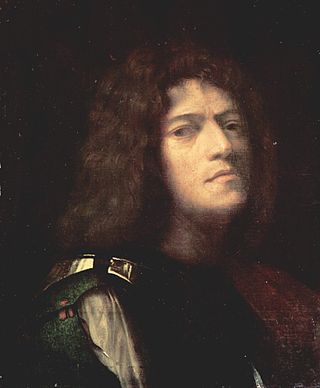
Giorgione was an Italian painter of the Venetian school during the High Renaissance, who died in his thirties. He is known for the elusive poetic quality of his work, though only about six surviving paintings are firmly attributed to him. The uncertainty surrounding the identity and meaning of his work has made Giorgione one of the most mysterious figures in European art.
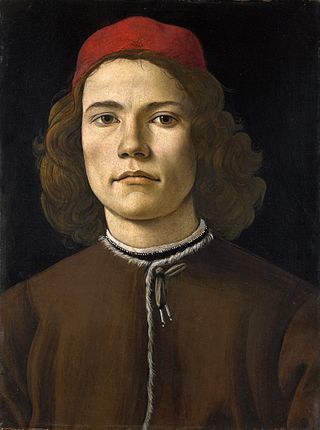
Portrait of a Young Man is a tempera on panel painting by the Italian Renaissance artist Sandro Botticelli, c. 1483, housed in the National Gallery in London.

Laura, sometimes known as Portrait of a Young Bride, is a 1506 oil on canvas painting by the Italian Renaissance master Giorgione. It is the only known painting of the author that was signed and dated by him. This work marked Giorgione's abandonment of Giovanni Bellini's models to embrace a Leonardesque style. It hangs in the Kunsthistorisches Museum in Vienna, Austria.

Vincenzo Catena was an Italian painter of the Renaissance Venetian school. He is also known as Vincenzo de Biagio.

La Schiavona, also known as Portrait of a Lady, is a 1510–1512 portrait by Titian of an unknown woman.
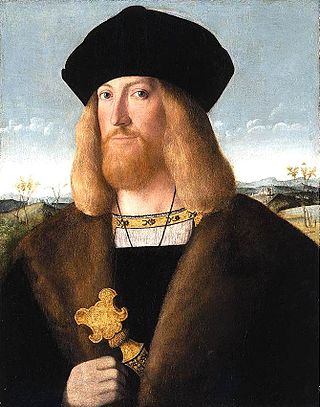
Bartolomeo Veneto was an Italian painter who worked in Venice, the Veneto, and Lombardy. During his time in Venice, he studied under Gentile Bellini. The little information available about Bartolomeo's life has been derived from his signatures, dates, and inscriptions. His best-known works are portraits or pictures with portrait-like character. Bartolomeo's later works, and especially those done on commission in Milan, indicate an influence from the artist Leonardo da Vinci.
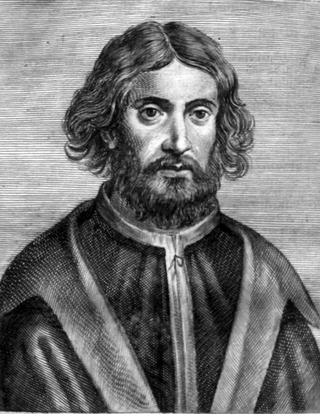
Palma Vecchio, born Jacopo Palma, also known as Jacopo Negretti, was a Venetian painter of the Italian High Renaissance. He is called Palma Vecchio in English and Palma il Vecchio in Italian to distinguish him from Palma il Giovane, his great-nephew, who was also a painter.
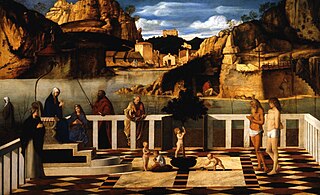
The Holy Allegory is a painting by the Italian Renaissance master Giovanni Bellini, dating from c. 1490 to 1500. It is in the Uffizi gallery in Florence, Italy.

Saints Christopher, Jerome and Louis of Toulouse is an oil-on-panel painting by the Italian Renaissance artist Giovanni Bellini, executed in 1513, and housed in the church of San Giovanni Crisostomo, Venice.

The Portrait of Francesco delle Opere is a painting by the Italian Renaissance artist Perugino, dating to 1494 and housed in the Uffizi Gallery, Florence.

A Man with a Quilted Sleeve is a painting of about 1510 by the Venetian painter Titian in the National Gallery, London, measuring 81.2 by 66.3 centimetres. Though the quality of the painting has always been praised, there has been much discussion as to the identity of the sitter. It was long thought to be a portrait of Ariosto, then a self-portrait, but in 2017 is called Portrait of Gerolamo (?) Barbarigo by the gallery, having also been called merely Portrait of a Man, the title used here, The Man with the Blue Sleeve, and no doubt other variants.

Flora is an oil painting by Italian late Renaissance painter Titian, dated to around 1515 and now held at the Uffizi Gallery in Florence.

The Gypsy Madonna is a panel painting of the Madonna and Child in oils of about 1510–11, by Titian, now in the Kunsthistorisches Museum in Vienna. It is a painting made for display in a home rather than a church.

The Three Ages of Man or Reading a Song is a 1500-1501 painting by Giorgione, now displayed at the Galleria Palatina within the Palazzo Pitti in Florence.

Shepherd with a flute, or Boy with a Pipe, is a painting in oil on canvas of perhaps 1510–1515, in recent decades usually attributed to Titian, though in the past often to Giorgione. It is now in the Royal Collection in the King's Closet at Windsor Castle. Since at least 1983 it has been called Boy with a Pipe by the Royal Collection; previous titles the collection recognise include Shepherd with a pipe, and The Shepherd.

Léal Souvenir is a small oil-on-oak panel portrait by the Early Netherlandish painter Jan van Eyck, dated 1432. The sitter has not been identified, but his highly individual features suggest a historical person rather than the hypothetical ideal usual at the time in northern Renaissance portraiture; his slight and unassuming torso is contrasted with a sophisticated facial expression. His features have been described as "plain and rustic", yet thoughtful and inward-looking. A number of art historians, including Erwin Panofsky, have detected mournfulness in his expression. The sitter was apparently significant enough a member of the Burgundian duke Philip the Good's circle that his court painter portrayed him.

Portrait of a Knight of Malta is a c.1515 oil on canvas painting by Titian of a knight belonging to the Order of Malta. It is now in the Uffizi in Florence. The last bead of the rosary held by the knight bears the number XXXV (35), showing the subject's age at the time of the portrait. W.F. Dickes. argued that he was Stefano Colonna, the condottiero who led the republican resistance during the siege of Florence. cited in

Detroit Trio, also titled The Appeal, is an oil on canvas painting attributed to Giorgione, Titian and Sebastiano del Piombo, executed c. 1500, now in the Detroit Institute of Arts.

The Pastoral Concert or Le Concert Champêtre is an oil painting of c. 1509 attributed to the Italian Renaissance master Titian. It was previously attributed to his fellow Venetian and contemporary Giorgione. It is located in the Musée du Louvre in Paris.




















